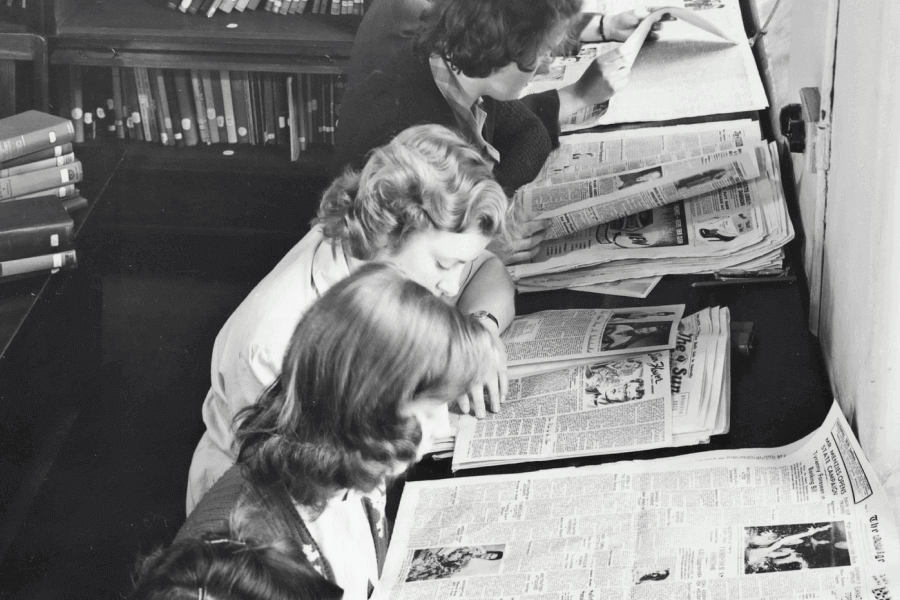HAZEL:
Tom, could I ask you for some advice, please?
TOM:
Yes of course, if you think I can help. What’s it about?
HAZEL:
It’s my first media studies assignment, and I’m not sure how to go about it. You must have done it last year.
TOM:
Is that the one comparing the coverage of a particular story in a range of newspapers?
TOM:
Oh yes, I really enjoyed writing it.
HAZEL:
So what sort of things do I need to compare?
TOM:
Well, there are several things. For example, there’s the question of which page of the newspaper the item appears on.
HAZEL:
You mean, because there’s a big difference between having it on the front page and the bottom of page ten, for instance?
TOM:
Exactly. And that shows how important the editor thinks the story is. Then there’s the size – how many column inches the story is given, how many columns it spreads over.
HAZEL:
And I suppose that includes the headline.
TOM:
It certainly does. It’s all part of attracting the reader’s attention.
HAZEL:
What about graphics – whether there’s anything visual in addition to the text?
TOM:
Yes, you need to consider those, too, because they can have a big effect on the reader’s understanding of the story – sometimes a bigger effect than the text itself. Then you’ll need to look at how the item is put together: what structure is it given?
TOM:
Bear in mind that not many people read beyond the first paragraph, so what has the journalist put at the beginning? And if, say, three are conflicting opinions about something, does one appear near the end, where people probably won’t read it?
HAZEL:
And newspapers sometimes give wrong or misleading information, don’t they?
TOM:
Yes, if you can. Compare what’s in different versions, and as far as possible, try and work out what’s true and what isn’t. And that relates to a very important point: what’s the writer’s purpose, or at least the most important one, if they have several.
TOM:
It may seem to be to inform the public, but often it’s that they want to create fear, or controversy, or to make somebody look ridiculous.
HAZEL:
Gosh, I see what you mean. And I suppose the writer may make assumptions about the reader.
TOM:
That’s right – about their knowledge of the subject, their attitudes, and their level of education, which means writing so that the readers understand without feeling patronised. All of that will make a difference to how story is presented.
HAZEL:
Does it matter what type of story I write about?
TOM:
No – national or international politics, the arts … Anything, as long as it’s covered in two or three newspaper. Though of course it’ll be easier and more fun if it’s something you’re interested in and know something about.
HAZEL:
And on that basis a national news item would be worth analysing – I’m quite keen on politics, so I’ll try and find a suitable topic. What did you choose for your analysis, Tom?
TOM:
I was interested in how newspapers express their opinions explicitly, so I wanted to compare editorials in different papers, but when I started looking. I couldn’t find two on the same topic that I felt like analysing.
HAZEL:
In that case, I won’t even bother to look.
TOM:
So in the end I chose a human interest story – a terribly emotional story about a young girl who was very ill, and lots of other people – mostly strangers – raised money so she could go abroad for treatment.
TOM:
Actually, I was surprised – some papers just wrote about how wonderful everyone was, but others considered the broader picture, like why treatment wasn’t available here.
HAZEL:
Hmm, I usually find stories like that raise quite strong feelings in me! I’ll avoid that . Perhaps I’ll choose an arts topic, like different reviews of a film, or something about funding for the arts – I’ll think about that.
TOM:
Yes, that might be interesting.
HAZEL:
OK, well thanks a lot for your help, Tom. It’s been really useful.
TOM:
You’re welcome. Good luck with the assignment, Hazel.
 Từ loại cần điền là một noun, một cái gì đó mà tin tức đó ở trên
Từ loại cần điền là một noun, một cái gì đó mà tin tức đó ở trên Sau khi nghe "So what sort of things do I need to compare?" là biết đáp án chuẩn bị vào.
Sau khi nghe "So what sort of things do I need to compare?" là biết đáp án chuẩn bị vào. Sau đó nghe "For example, there’s the question of which page of the newspaper the item appears on."
Sau đó nghe "For example, there’s the question of which page of the newspaper the item appears on." 


